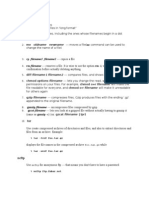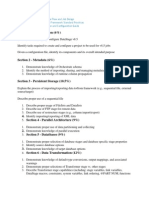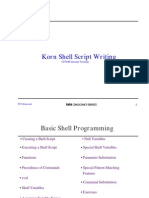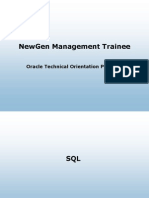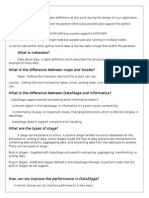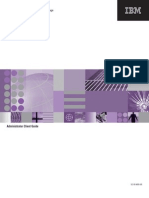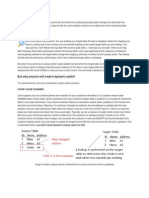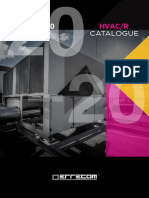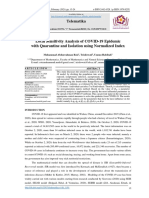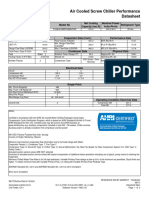Unix Interview Questions
Unix Interview Questions
Uploaded by
Omkar RayapeddiCopyright:
Available Formats
Unix Interview Questions
Unix Interview Questions
Uploaded by
Omkar RayapeddiCopyright
Available Formats
Share this document
Did you find this document useful?
Is this content inappropriate?
Copyright:
Available Formats
Unix Interview Questions
Unix Interview Questions
Uploaded by
Omkar RayapeddiCopyright:
Available Formats
Unix Interview Questions- Commands Unix Commands Interview Questions 1) State and explain about features of UNIX?
UNIX operating system originally was developed in 1969. This is an open source operating system developed by AT&T. It is widely used in work stations and servers. It is designed to be multi tasking, multi user and portable. UNIX has many several components packed together. 2) Explain about sh? Sh is the command line interpreter and it is the primary user interface. This forms the programmable command line interpreter. After windows appeared it still retained the programmable characteristics. 3) Explain about system and user utilities? There are two utilities they are system and user utilities. System utilities contain administrative tools such as mkfs, fsck, etc. Where as user utilities contain features such as passwd, kill, etc. It basically contains environment values. 4) Explain about document formatting? UNIX systems were primarily used for typesetting systems and document formatting. Modern UNIX systems used packages such as Tex and Ghostscript. It uses some of the programs such as nroff, tbl, troff, refer, eqn and pic. Document formatting is very used because it forms the base of UNIX. 5) Explain about communication features in UNIX? Early UNIX systems used inter user communication programs mail and write commands. They never contained a fully embedded inter user communication features. Systems with BSD included TCP/IP protocols. 6) Explain about chmod options filename? This command allows you to change, write, read and execute permissions on your file. Changes can be done to the file system but at times you need to change permissions for the file systems. At times files should be executable for viewing the files. 7) Explain about gzip filename? Gzip filename is used to compress the files so that those files take up less space. The size of the file actually gets reduced to half their size but they might also depend upon about the file size and nature of the file systems. Files using gzip file name end with .gz. 8) Explain about refer? Refer was written in Bell Laboratories and it is implemented as a troff preprocessor. This program is used managing bibliographic references and it is used to cite them in troff documents. It is offered in most of the UNIX packages. It refers with text and reference file. 9) Explain about lpr filename? This command is used to print a file. If you want to change the default print you can change the printer by using the P option. For double sided print you can use lpr-Pvalkyr-d. This is very useful command in UNIX present in many packages.
10) Explain about lprm job number? This command is used to remove documents from the printer queue. The job number or the queue number can be found by using lpq. Printer name should be specified but this is not necessary if you want to use your default printer. 11) Brief about the command ff? This command finds files present anywhere on the system. This command is used to find document location where you forgot the directory in which you kept the file but you do remember about the name. This command is not restricted in finding files it displays files and documents relevant to the name. 12) Brief about finger username? This command is used to give information about the user; it gives out a profile about the user. This command is very useful for administrators as it gives the log information, email, current log information, etc. finger also displays information such as phone number and name when they use a file called .plan. 13) Explain about the command elm? This command lets you to send email message from your system. This command is not the only one which sends email there are lots of other messenger systems which can facilitate the process of sending a mail. This command behaves differently on different machines. 14) Brief about the command kill PID? This command ends the process to which it was assigned (ID). This command cannot be used in multi systems in the network. ID can be obtained by the command ps. This command ignores completely the state at which the process is it kills the process. 15) Explain about the command lynx? This command helps you to browse web from an ordinary terminal. Text can be seen but not the pictures. URL can be assigned as an argument to the G command. Help section can be obtained by pressing H and Q makes the program to quit. 16) Brief about the command nn? This command allows you to read the news. First you can read about the local news and then the remote news. "nnl command makes or allows you to read local news and nnr command is used to read remote news. Manual and help information is available with many popular packages. 17) Brief about ftp hostname? This command lets you download information, documents, etc from a remote ftp. First it is important to configure an FTP for the process to begin. Some of the important commands relevant to the usage of FTP are as follows get, put, mget, mput, etc. If you are planning to transfer files other than ASCII defined it is imperative to use binary mode.
UNIX Commands Interview Questions
1. Construct pipes to execute the following jobs. 1. Output of who should be displayed on the screen with value of total number of users who have logged in displayed at the bottom of the list. 2. Output of ls should be displayed on the screen and from this output the lines containing the word poem should be counted and the count should be stored in a file. 3. Contents of file1 and file2 should be displayed on the screen and this output should be appended in a file . From output of ls the lines containing poem should be displayed on the screen along with the count. 4. Name of cities should be accepted from the keyboard . This list should be combined with the list present in a file. This combined list should be sorted and the sorted list should be stored in a file newcity. 5. All files present in a directory dir1 should be deleted any error while deleting should be stored in a file errorlog. 2. Explain the following commands. $ ls > file1 $ banner hi-fi > message $ cat par.3 par.4 par.5 >> report $ cat file1>file1 $ date ; who $ date ; who > logfile $ (date ; who) > logfile 3. What is the significance of the tee command? It reads the standard input and sends it to the standard output while redirecting a copy of what it has read to the file specified by the user. 4. What does the command $who | sort logfile > newfile do? The input from a pipe can be combined with the input from a file . The trick is to use the special symbol - (a hyphen) for those commands that recognize the hyphen as std input. In the above command the output from who becomes the std input to sort , meanwhile sort opens the file logfile, the contents of this file is sorted together with the output of who (rep by the hyphen) and the sorted output is redirected to the file newfile. 5. What does the command $ls | wc l > file1 do? ls becomes the input to wc which counts the number of lines it receives as input and instead of displaying this count , the value is stored in file1. 6. Which of the following commands is not a filter man , (b) cat , (c) pg , (d) head Ans: man
A filter is a program which can receive a flow of data from std input, process (or filter) it and send the result to the std output. 7. How is the command $cat file2 different from $cat >file2 and >> redirection operators ? is the output redirection operator when used it overwrites while >> operator appends into the file. 9. Explain the steps that a shell follows while processing a command. After the command line is terminated by the key, the shel goes ahead with processing the command line in one or more passes. The sequence is well defined and assumes the following order. Parsing: The shell first breaks up the command line into words, using spaces and the delimiters, unless quoted. All consecutive occurrences of a space or tab are replaced here with a single space. Variable evaluation: All words preceded by a $ are avaluated as variables, unless quoted or escaped. Command substitution: Any command surrounded by backquotes is executed by the shell which then replaces the standard output of the command into the command line. Wild-card interpretation: The shell finally scans the command line for wild-cards (the characters *, ?, [, ]). Any word containing a wild-card is replaced by a sorted list of filenames that match the pattern. The list of these filenames then forms the arguments to the command. PATH evaluation: It finally looks for the PATH variable to determine the sequence of directories it has to search in order to hunt for the command. 10. What difference between cmp and diff commands? cmp - Compares two files byte by byte and displays the first mismatch diff - tells the changes to be made to make the files identical 11. What is the use of grep command? grep is a pattern search command. It searches for the pattern, specified in the command line with appropriate option, in a file(s). Syntax : grep Example : grep 99mx mcafile 12. What is the difference between cat and more command? Cat displays file contents. If the file is large the contents scroll off the screen before we view it. So command 'more' is like a pager which displays the contents page by page. 13. Write a command to kill the last background job? Kill $! 14. Which command is used to delete all files in the current directory and all its subdirectories? rm -r * 15. Write a command to display a files contents in various formats? $od -cbd file_name c - character, b - binary (octal), d-decimal, od=Octal Dump. 16. What will the following command do? $ echo *
It is similar to 'ls' command and displays all the files in the current directory. 17. Is it possible to create new a file system in UNIX? Yes, mkfs is used to create a new file system. 18. Is it possible to restrict incoming message? Yes, using the mesg command. 19. What is the use of the command "ls -x chapter[1-5]" ls stands for list; so it displays the list of the files that starts with 'chapter' with suffix '1' to '5', chapter1, chapter2, and so on. 20. Is du a command? If so, what is its use? Yes, it stands for disk usage. With the help of this command you can find the disk capacity and free space of the disk. 21. Is it possible to count number char, line in a file; if so, How? Yes, wc-stands for word count. wc -c for counting number of characters in a file. wc -l for counting lines in a file. 22. Name the data structure used to maintain file identification? inode, each file has a separate inode and a unique inode number. 23. How many prompts are available in a UNIX system? Two prompts, PS1 (Primary Prompt), PS2 (Secondary Prompt). 24. How does the kernel differentiate device files and ordinary files? Kernel checks 'type' field in the file's inode structure. 25. How to switch to a super user status to gain privileges? Use su command. The system asks for password and when valid entry is made the user gains super user (admin) privileges. 26. What are shell variables? Shell variables are special variables, a name-value pair created and maintained by the shell. Example: PATH, HOME, MAIL and TERM 27. What is redirection? Directing the flow of data to the file or from the file for input or output. Example : ls > wc 28. How to terminate a process which is running and the specialty on command kill 0? With the help of kill command we can terminate the process. Syntax: kill pid Kill 0 - kills all processes in your system except the login shell. 29. What is a pipe and give an example? A pipe is two or more commands separated by pipe char '|'. That tells the shell to arrange for the output of the preceding command to be passed as input to the following command. Example : ls -l | pr The output for a command ls is the standard input of pr. When a sequence of commands are combined using pipe, then it is called pipeline. 30. Explain kill() and its possible return values. There are four possible results from this call: kill() returns 0. This implies that a process exists with the given PID, and the system would allow you to send signals to it. It is system-dependent whether the process could be a zombie.
kill() returns -1, errno == ESRCH either no process exists with the given PID, or security enhancements are causing the system to deny its existence. (On some systems, the process could be a zombie.) kill() returns -1, errno == EPERM the system would not allow you to kill the specified process. This means that either the process exists (again, it could be a zombie) or draconian security enhancements are present (e.g. your process is not allowed to send signals to *anybody*). kill() returns -1, with some other value of errno you are in trouble! The most-used technique is to assume that success or failure with EPERM implies that the process exists, and any other error implies that it doesn't. An alternative exists, if you are writing specifically for a system (or all those systems) that provide a /proc filesystem: checking for the existence of /proc/PID may work.
You might also like
- School Management System Project DocumentationDocument34 pagesSchool Management System Project DocumentationJoshua Blessing100% (3)
- ASME B31.9 - 2014 Building Services Piping Pages 1 - 50 - Text Version - AnyFlipDocument89 pagesASME B31.9 - 2014 Building Services Piping Pages 1 - 50 - Text Version - AnyFlipEstuardo Olan100% (5)
- Unix Comands For DatastageDocument2 pagesUnix Comands For DatastageJGHSAJKHNo ratings yet
- Teradata Basics Exam - Sample Question Set 1 (Answers in Italic Font)Document5 pagesTeradata Basics Exam - Sample Question Set 1 (Answers in Italic Font)Vishal GuptaNo ratings yet
- BMC Control-M 7: A Journey from Traditional Batch Scheduling to Workload AutomationFrom EverandBMC Control-M 7: A Journey from Traditional Batch Scheduling to Workload AutomationNo ratings yet
- SERVO 954-ManualDocument304 pagesSERVO 954-ManualCESARNo ratings yet
- Owc ReportDocument196 pagesOwc Reportacdc100% (1)
- UNIX Shell Scripting Interview Questions, Answers, and Explanations: UNIX Shell Certification ReviewFrom EverandUNIX Shell Scripting Interview Questions, Answers, and Explanations: UNIX Shell Certification ReviewRating: 4.5 out of 5 stars4.5/5 (4)
- UNIX Shell Programming Interview Questions You'll Most Likely Be AskedFrom EverandUNIX Shell Programming Interview Questions You'll Most Likely Be AskedNo ratings yet
- UNIX Command Questions Answers Asked in InterviewDocument25 pagesUNIX Command Questions Answers Asked in Interviewvishwanath cNo ratings yet
- Unix CommandsDocument10 pagesUnix CommandsMohammed ParvezNo ratings yet
- Active Console 2 Reference Manual: Europe, Middle East & AfricaDocument110 pagesActive Console 2 Reference Manual: Europe, Middle East & AfricaVishwaknarayanNo ratings yet
- SQL DifferenceDocument61 pagesSQL DifferenceMahesh kumarNo ratings yet
- Teradata Informatica Best PracticesDocument22 pagesTeradata Informatica Best PracticesNeelam_Mohanty4214No ratings yet
- Informatica PowerCenter Version 9Document3 pagesInformatica PowerCenter Version 9Monalisa MurugesanNo ratings yet
- What To Use When: Azure Data and SQL ServerDocument48 pagesWhat To Use When: Azure Data and SQL ServerMarianoKovoNo ratings yet
- IBM Informatica Technical QuestionsDocument3 pagesIBM Informatica Technical QuestionskodandaNo ratings yet
- 10 Linux and UNIX Interview Questions and Answers Asked in Wipro TCS CapegeminiDocument1 page10 Linux and UNIX Interview Questions and Answers Asked in Wipro TCS CapegeminiShitesh SachanNo ratings yet
- Data Warehousing QuestionsDocument12 pagesData Warehousing QuestionsRajesh ChowhanNo ratings yet
- Datastage Interview QuestionsDocument10 pagesDatastage Interview QuestionsKalyan KrishnaNo ratings yet
- Shell Porgramming AssignmentDocument44 pagesShell Porgramming AssignmentTanmay MasurkarNo ratings yet
- New Informatica Concepts - DayDocument98 pagesNew Informatica Concepts - DayChanukya Reddy Mekala100% (1)
- Unix CommandsDocument8 pagesUnix Commands12prasad12No ratings yet
- Unix - Day 1: Intermediate LevelDocument46 pagesUnix - Day 1: Intermediate LevelPraveen KumarNo ratings yet
- Ramana Informatica2Document21 pagesRamana Informatica2vungaralavijaybtechNo ratings yet
- Other Companies Interview QuestionsDocument43 pagesOther Companies Interview QuestionsBhaskar ReddyNo ratings yet
- Some Basic UNIX CommandsDocument6 pagesSome Basic UNIX CommandsLakshminarayana SamaNo ratings yet
- Error Handling in InformaticaDocument4 pagesError Handling in InformaticakiNo ratings yet
- Complete Unix CommandsDocument66 pagesComplete Unix Commandssushant sNo ratings yet
- Informatica: Business Information GroupDocument30 pagesInformatica: Business Information GroupVijayabharathi SingaramNo ratings yet
- Informatica Session Properties Presentation1Document18 pagesInformatica Session Properties Presentation1Vicky BindassNo ratings yet
- Teradata Beginner's Guide - ArchitectureDocument12 pagesTeradata Beginner's Guide - ArchitecturenirmalphNo ratings yet
- Basic SQL Queries (P-3)Document18 pagesBasic SQL Queries (P-3)SuperstarNo ratings yet
- Teradata UtilitiesDocument17 pagesTeradata Utilitiesyogeeswar5b9No ratings yet
- Datastage Transformer FunctionsDocument71 pagesDatastage Transformer FunctionsAnonymousHPNo ratings yet
- Teradata UtilitiesDocument88 pagesTeradata Utilitiessiva86No ratings yet
- Advanced UNIX CommandsDocument3 pagesAdvanced UNIX CommandsRockyNo ratings yet
- Welcome To The Finest Collection of Informatica Interview Questions With Standard Answers That You Can Count OnDocument60 pagesWelcome To The Finest Collection of Informatica Interview Questions With Standard Answers That You Can Count OnDinesh AilaNo ratings yet
- Datastage CertificationDocument3 pagesDatastage CertificationPadmavathy ManoharNo ratings yet
- Informatica Interview Questions On TransformationsDocument112 pagesInformatica Interview Questions On Transformationsvinayreddy460No ratings yet
- DataStage Interview QuestionsDocument3 pagesDataStage Interview QuestionsvrkesariNo ratings yet
- Unix Commands-AbhiDocument18 pagesUnix Commands-AbhiNishant HingneNo ratings yet
- DocDocument500 pagesDocMonica MarciucNo ratings yet
- Korn Shell Script WritingDocument87 pagesKorn Shell Script WritingRatna NedunuriNo ratings yet
- Newgen Management Trainee: Oracle Technical Orientation ProgramDocument41 pagesNewgen Management Trainee: Oracle Technical Orientation ProgrammsatheshchendraNo ratings yet
- Issues DatastageDocument4 pagesIssues DatastagerkpoluNo ratings yet
- How To Use Unix in Informatica-Cod - SCRDocument5 pagesHow To Use Unix in Informatica-Cod - SCRRajan SinghNo ratings yet
- Unix Interview Questions and AnswersDocument4 pagesUnix Interview Questions and AnswersatoztargetNo ratings yet
- Manual Informatica PowercenterDocument318 pagesManual Informatica PowercenterEder GeraldoNo ratings yet
- Datastage PointsDocument26 pagesDatastage PointsNaresh KumarNo ratings yet
- SQL Quick Syntax GuideDocument126 pagesSQL Quick Syntax GuideAnkitaBansalGargNo ratings yet
- Apps DBA QuestionsDocument422 pagesApps DBA QuestionsNarasimha RaoNo ratings yet
- Job SequencerDocument19 pagesJob Sequenceraddubey2No ratings yet
- DataStage AdminguideDocument40 pagesDataStage Adminguiderpentapati0% (1)
- But Why Anyone Will Need A Dynamic Cache?Document8 pagesBut Why Anyone Will Need A Dynamic Cache?sanjay.gupta8194No ratings yet
- Unix and SQL Interview Questions&AnswersDocument1 pageUnix and SQL Interview Questions&Answersrit123_comNo ratings yet
- Pro Oracle SQL Development: Best Practices for Writing Advanced QueriesFrom EverandPro Oracle SQL Development: Best Practices for Writing Advanced QueriesNo ratings yet
- Oracle SOA BPEL Process Manager 11gR1 A Hands-on TutorialFrom EverandOracle SOA BPEL Process Manager 11gR1 A Hands-on TutorialRating: 5 out of 5 stars5/5 (1)
- Trip SheetDocument2 pagesTrip SheetZIANINo ratings yet
- Unit 1 & 2Document79 pagesUnit 1 & 2Malav PatelNo ratings yet
- Mathematics Resource Package: Quarter I Subject: MATH Date: - Day: 1 Content StandardDocument12 pagesMathematics Resource Package: Quarter I Subject: MATH Date: - Day: 1 Content StandardLowie D GacetaNo ratings yet
- Incident Management ProcedureDocument13 pagesIncident Management ProceduremarynabaizhanovaNo ratings yet
- Behavioral Modeling: - Interaction DiagramsDocument26 pagesBehavioral Modeling: - Interaction DiagramsPallavi BhartiNo ratings yet
- Allama Iqbal Open University, Islamabad (Department of Business Administration) WarningDocument5 pagesAllama Iqbal Open University, Islamabad (Department of Business Administration) WarningZeeshanNo ratings yet
- Technical Specifications For The Mobile Oil Hydraulic Power PackDocument4 pagesTechnical Specifications For The Mobile Oil Hydraulic Power PackdebasisNo ratings yet
- D275 Monitoring Mode TableDocument5 pagesD275 Monitoring Mode Tableluis eduardo corzo enriquezNo ratings yet
- Solve,the Mckinsey Game (游戏分析指南书)Document40 pagesSolve,the Mckinsey Game (游戏分析指南书)sjNo ratings yet
- Seminar Report - MergedDocument28 pagesSeminar Report - Mergednikhilreddyg1433No ratings yet
- Variations of Selendang SuteraDocument10 pagesVariations of Selendang SuteraLydia UtamiNo ratings yet
- A. DatetimeDocument98 pagesA. Datetimekrizhna4u50% (2)
- 11th Computer Science Chapter 11 Study Material emDocument7 pages11th Computer Science Chapter 11 Study Material emJalagandeeswaran KalimuthuNo ratings yet
- 3.sample Piping Layouts of A Water Supply &Document23 pages3.sample Piping Layouts of A Water Supply &elcid agsamosamNo ratings yet
- Errecom Hvacr CompressDocument88 pagesErrecom Hvacr CompresscosminsolomonNo ratings yet
- FFT - Proactive Advanced Endpoint Protection, Visiblity and Control For Critical Assets v6.4r8 Lab GuideDocument126 pagesFFT - Proactive Advanced Endpoint Protection, Visiblity and Control For Critical Assets v6.4r8 Lab GuideSony EscriNo ratings yet
- SCVCST - Synchro-Check/ Voltage-Check Function Stage 1 (Scvcst1) Stage 2 (Scvcst2)Document22 pagesSCVCST - Synchro-Check/ Voltage-Check Function Stage 1 (Scvcst1) Stage 2 (Scvcst2)rajeshNo ratings yet
- Telematika: Muhammad Abdurrahman Rois, Trisilowati, Ummu HabibahDocument12 pagesTelematika: Muhammad Abdurrahman Rois, Trisilowati, Ummu Habibahrizka rizqi robbyNo ratings yet
- Viisights - Critical-Infrastructure and Border-Security Solution Deck 2023Document44 pagesViisights - Critical-Infrastructure and Border-Security Solution Deck 2023Marius Cristian CostiucNo ratings yet
- ProjectDocument11 pagesProjectAtul BeniwalNo ratings yet
- YVAA0233 (MTY) at 95 F - DataSheetSpecDocument2 pagesYVAA0233 (MTY) at 95 F - DataSheetSpecMohammed EmamNo ratings yet
- Rtl8367rb CG RealtekDocument78 pagesRtl8367rb CG RealtekNadya Mariela ShamaraNo ratings yet
- California Bearing RatioDocument20 pagesCalifornia Bearing Ratiodardar curryNo ratings yet
- DSHG - Válvula DirecionalDocument33 pagesDSHG - Válvula DirecionalAlessandro OliveiraNo ratings yet
- 4.3.7.1 - DWG TR Cab 01 00 02-ADocument1 page4.3.7.1 - DWG TR Cab 01 00 02-ASabit HasanNo ratings yet
- Elektor USA - October 2014 PDFDocument92 pagesElektor USA - October 2014 PDFJean-Pierre Desrochers100% (4)























